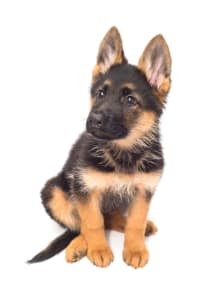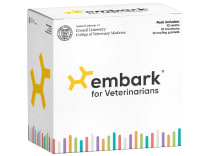The most popular breeds in America tend to be larger dogs with dependable temperaments to get their job done, whether in the home, in the field, or in a professional career. Four of the most common breeds are the Labrador Retriever, French Bulldog, German Shepherd Dog, and Golden Retriever. Genetic health risks listed for each breed are percentages based on the clear, carrier, and at-risk status of a subset of dogs within the Embark database and do not necessarily represent all dogs of each breed. While we are not able to provide specific population numbers at this time, we believe the data provided here to be sufficient to inform on current trends within the North American population of each breed.
Common genetic health risks for German Shepherd Dogs

The German Shepherd Dog is a loyal and affectionate dog with innate herding abilities. With its incredible sense of smell and high intelligence, this breed excels at military and police work and as a search and rescue dog.
Embark Veterinary offers 12 breed-specific genetic health tests for the German Shepherd Dog among its 270+ genetic health conditions tested for in the full panel. These are the most common genetic conditions based on Embark data, ranked from most to least prevalent, in the German Shepherd Dog, with less than 95% of dogs testing clear.
Degenerative Myelopathy, DM (SOD1A)
The dog equivalent of Amyotrophic Lateral Sclerosis, or Lou Gehrig’s disease, DM is a progressive degenerative disorder of the spinal cord. Because the nerves that control the hind limbs are the first to degenerate, the most common clinical signs are back muscle wasting and gait abnormalities. The gene is SOD1A* and the mode of inheritance is recessive.
* SOD1A VS SOD1B
Please note: While we test for the SOD1A variant, we do not test for the SOD1B (Bernese Mountain Dog type) variant at this time. Degenerative Myelopathy genotype results apply only to SOD1A.
- Based on Embark-tested German Shepherd Dogs that have opted into research, here’s a snapshot of the breed today: 66.99% of dogs tested clear, 29.1% tested carriers, and 3.9% tested at-risk for Degenerative Myelopathy DM.
Citations: Awano et al 2009 Shelton et al 2012 Capuccio et al 2014
Common genetic health risks for Golden Retrievers

The Golden Retriever is an ideal hunting retriever with a sweet disposition and eager-to-please attitude, which makes it a very popular family companion. The breed’s golden coat comes in shades from deep red to pale yellow due to red pigment intensity. Thanks to a recent discovery by Embark, scientists have discovered additional details on what causes this intensity of red pigmentation in a dog’s coat.
Embark Veterinary offers 11 breed-specific genetic health tests for the Golden Retriever among its 270+ genetic health conditions tested for in the full panel. These are the most common genetic conditions based on Embark data, ranked from most to least prevalent, in the Golden Retriever with less than 95% of dogs testing clear.
Ichthyosis, ICH1 (PNPLA1, Golden Retriever Variant)
Ichthyosis, ICH1 (PNPLA1, Golden Retriever Variant) is a skin disorder gets its name from the thick, darkly pigmented scales of skin (“ichthys” is Greek for “fish”) that affected dogs display on their skin. Ichthyotic dogs typically have large, greasy flakes of dandruff, but aren’t itchy. The scales of skin can get so thick that they can crack and cause fissures, leading to considerable discomfort. The gene is PNPLA1 (Exon 8) and the mode of inheritance is recessive.
- Based on Embark-tested Golden Retrievers that have opted into research, here’s a snapshot of the breed today: 55.4% of dogs tested clear, 37.5% tested carriers, and 7% tested at-risk for Ichthyosis, ICH1 (PNPLA1, Golden Retriever Variant).
Citations: Grall et al 2012
Golden Retriever Progressive Retinal Atrophy 2, GR-PRA2 (TTC8)
Golden Retriever PRA 2 is a retinal disease that causes progressive, non-painful vision loss. The retina contains cells, called photoreceptors, that collect information about light and send signals to the brain. There are two types of photoreceptors: rods, for night vision and movement, and cones, for day vision and color. This type of PRA leads to early loss of rod cells, leading to night blindness before day blindness. The gene is TTC8 Exon 8 and the mode of inheritance is recessive.
- Based on Embark-tested Golden Retrievers that have opted into research, here’s a snapshot of the breed today: 95% of dogs tested clear, 4.9% tested carriers, and <0.1% tested at-risk for Golden Retriever Progressive Retinal Atrophy 2, GR-PRA2 (TTC8).
Citations: Downs et al 2013
Common genetic health risks for Labrador Retrievers

The friendly, dependable, and ubiquitous Labrador Retriever has been America’s top dog breed for over three decades. With so many Labs as pets, working dogs, and service dogs, veterinarians will see some of the most common genetic health diseases associated with the breed at their clinics.
Embark Veterinary offers 20 breed-specific genetic health tests for the Labrador Retriever among its 270+ genetic health conditions tested for in the full panel. Below are the most common genetic conditions based on Embark data, ranked from most to least prevalent, in the Labrador Retriever, with less than 95% of dogs testing clear.
Stargardt Disease (ABCA4 Exon 28, Labrador Retriever Variant)
Stargardt Disease is a non-painful inherited degenerative disorder of the rod and cone photoreceptor cells of the retina that results in vision loss. Rods affect vision in the dark, or low light, and cones affect vision in light. As the disease progresses, cone function is profoundly abnormal, whereas rod function is better preserved. Vision slowly deteriorates, but some vision remains throughout an affected dog’s lifetime. The mode of inheritance is recessive.
- Based on Embark-tested Labrador Retrievers that have opted into research, here’s a snapshot of the breed today: 79.1% of dogs tested clear, 18.8% tested carriers, and 1.3% tested at-risk for Stargardt Disease.
Citations: Makelainen et al 2019 Ekesten et al 2022
Exercise-Induced Collapse, EIC (DNM1)
EIC, a muscular disorder, has been linked to a mutation in the DNM1 gene, which codes for the protein dynamin. In the neuron, dynamin trucks neurotransmitter-filled vesicles from the cell body, where they are generated, to the dendrites. It is hypothesized in dogs affected with EIC, the mutation in DNM1 disrupts efficient neurotransmitter release, leading to a cessation in signaling and EIC. The mode of inheritance is recessive.
- Based on Embark-tested Labrador Retrievers that have opted into research, here’s a snapshot of the breed today: 82.1% of dogs tested clear, 16.8% tested carriers, and 0.9% tested at-risk for Exercise-Induced Collapse, EIC (DNM1).
Citations: Patterson et al 2008
Progressive Retinal Atrophy, prcd
PRA-prcd is a retinal disease that causes progressive, non-painful vision loss. The retina contains cells, called photoreceptors, that collect information about light and send signals to the brain. There are two types of photoreceptors: rods, for night vision and movement, and cones, for day vision and color. This type of PRA leads to early loss of rod cells, leading to night blindness before day blindness. The gene is PRCD Exon 1, and the mode of inheritance is recessive.
- Based on Embark-tested Labrador Retrievers that have opted into research, here’s a snapshot of the breed today: 87.5% of dogs tested clear, 11.9% tested carriers, and 0.5% tested at-risk for Progressive Retinal Atrophy, prcd.
Citations: Zangerl et al 2006
Common genetic health risks for French Bulldogs

The growing popularity of the French Bulldog as a smaller, affectionate companion in urban settings has created a great demand for this breed. Veterinarians are familiar with the health challenges of owning this breed, including some of the most common breed-specific genetic health risks.
Embark Veterinary offers six breed-specific genetic health tests for the French Bulldog among its 270+ genetic health conditions tested for in the full panel. These are the most common genetic conditions based on Embark data, ranked from most to least prevalent, in the French Bulldog, with less than 95% of dogs testing clear.
Chondrodystrophy and Intervertebral Disc Disease, CDDY/IVDD, Type I IVDD
Type I Intervertebral Disc Disease (IVDD) is a back or neck issue affecting the discs that act as cushions between vertebrae (the bones of the spine). With Type I IVDD, affected dogs can have an event where the disc ruptures or herniates towards the spinal cord. This pressure on the spinal cord causes neurologic signs ranging from pain to a wobbly gait to paralysis. Chondrodystrophy (CDDY) refers to the relative proportion between a dog’s legs and body, wherein the legs are shorter and the body longer.
Multiple different variants can cause a markedly chondrodystrophic appearance, as observed in Dachshunds and Corgis. However, this particular variant is the only one known also to increase the risk for IVDD. The gene is FGF4, and the mode of inheritance is dominant.
Many dog breeds, due to human selection for the desired appearance (phenotype), have a high frequency of this variant in the FGF4 retrogene, meaning most or all Frenchies have at least one copy of the variant. Therefore, breeding decisions cannot be made solely based on this breed variant.
- Based on Embark-tested French Bulldogs that have opted into research, here’s a snapshot of the breed today: 3.3% of dogs tested clear, 68.2% tested at-risk, homozygote, dominant and 28.3% at risk, heterozygote, dominant for Chondrodystrophy and Intervertebral Disc Disease, CDDY/IVDD, Type I IVDD
Citations: Brown et al 2017 Batcher et al 2019
Progressive Retinal Atrophy, crd4/cord1 (RPGRIP1)
PRA-CRD4/cord1 is a retinal disease that causes progressive, non-painful vision loss over a 1-2 year period. The retina contains cells, called photoreceptors, that collect information about light and send signals to the brain. There are two types of photoreceptors: rods, for night vision and movement, and cones, for day vision and color. This type of PRA leads to early loss of cone cells, causing day blindness before night blindness. The gene is RPGRIP1 (Exon 2), and the mode of inheritance is recessive. Research into this variant’s effect on this breed is ongoing, as some breeds seem to be clinically unaffected. Frenchie owners are encouraged to fill out Embark’s Annual Health Survey to characterize the variant in Frenchies.
- Based on Embark-tested French Bulldogs that have opted into research, here’s a snapshot of the breed today: 85.3% of dogs tested clear, 13.9% tested carriers, and 0.6% tested at-risk for Progressive Retinal Atrophy, crd4/cord1 (RPGRIP1).
Citations: Mellersh et al 2006
Canine Multifocal Retinopathy, cmr1 (BEST1 Exon 2)
Canine Multifocal Retinopathy, cmr1 is a non-progressive retinal disease that, in rare cases, can lead to vision loss. Dogs with larger retinal lesions can suffer from vision loss. CMR is fairly non-progressive; new lesions typically stop forming when a dog is an adult, and some lesions will even regress with time. The gene is BEST1/VMD2 (Exon 2), and the mode of inheritance is recessive.
- Based on Embark-tested French Bulldogs that have opted into research, here’s a snapshot of the breed today: 91.8% of dogs tested clear, 7.8% tested carriers, and 0.2% tested at-risk for Canine Multifocal Retinopathy, cmr1 (BEST1 Exon 2).
Citations: Guziewicz et al 2007 Hoffman et al 2012














